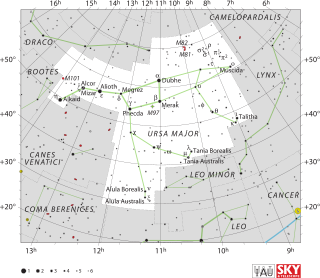 Location of π¹ Ursae Majoris (circled) | |
| Observation data Epoch J2000 Equinox J2000 | |
|---|---|
| Constellation | Ursa Major |
| Right ascension | 08 39 11.70440 |
| Declination | +65° 01′ 15.2667″ |
| Apparent magnitude (V) | 5.63 |
| Characteristics | |
| Spectral type | G1.5Vb |
| U−B color index | +0.07 |
| B−V color index | +0.62 |
| Variable type | BY Draconis |
| Astrometry | |
| Radial velocity (Rv) | –13.88 ± 0.47 km/s |
| Proper motion (μ) | RA: -27.44 ± 0.31 mas/yr Dec.: +88.13 ± 0.26 mas/yr |
| Parallax (π) | 69.66 ± 0.37 mas |
| Distance | 46.8 ± 0.2 ly (14.36 ± 0.08 pc) |
| Absolute magnitude (MV) | 4.86 |
| Details | |
| Mass | 0.90 M☉ |
| Luminosity | 0.97 L☉ |
| Surface gravity (log g) | 4.48 cgs |
| Temperature | 5,884 ± 6.8 K |
| Metallicity | –0.04 dex |
| Rotation | 5 days |
| Rotational velocity (v sin i) | 14.27 km/s |
| Age | 200 Myr |
| Other designations | |
| π¹ Ursae Majoris, π¹ UMa, Pi UMa, 3 Ursae Majoris, BD +65°643, GC 11817, HD 72905, HIP 42438, HR 3391, PPM 16705, SAO 14609. | |
| Database references | |
| SIMBAD | data |

Pi Ursae Majoris (Pi UMa, π¹ Ursae Majoris, π¹ UMa) is a yellow G-type main sequence dwarf with a mean apparent magnitude of +5.63. It is approximately 46.8 light years from Earth, and is a relatively young star with an age of about 200 million years. It is classified as a BY Draconis type variable star and its brightness varies by 0.08 magnitudes. In 1986, it became the first solar-type star to have the emission from an X-ray flare observed. Based upon its space velocity components, this star is a member of the Ursa Major moving group of stars that share a common motion through space.
An excess of infrared radiation has been detected from this system, which suggests the presence of a debris disk. The best fit to the data indicates that there is a ring of fine debris out to a radius of about 0.4 AU, consisting of 0.25 μm grains of amorphous silicates or crystalline forsterite. There may also be a wider ring of larger (10 μm) grains out to a distance of 16 AU.
Naming and etymology
With π, σ, σ, ρ, A and d, it composed the Arabic asterism Al Ṭhibā᾽, the Gazelle. According to the catalogue of stars in the Technical Memorandum 33-507 - A Reduced Star Catalog Containing 537 Named Stars, Al Ṭhibā were the title for seven stars : A as Althiba I, this star (π) as Althiba II, π as Althiba III, ρ as Althiba IV, σ as Althiba V, σ as Althiba VI, and d as Althiba VII.
References
- ^ van Leeuwen, Floor (2007). "Hipparcos, the new Reduction of the Raw data". Astron. Astrophys. 474 (2): 653–664. arXiv:0708.1752. Bibcode:2007A&A...474..653V. doi:10.1051/0004-6361:20078357. S2CID 18759600. Note: see VizieR catalogue I/311.
- Montes, D.; et al. (November 2001), "Late-type members of young stellar kinematic groups - I. Single stars", Monthly Notices of the Royal Astronomical Society, 328 (1): 45–63, arXiv:astro-ph/0106537, Bibcode:2001MNRAS.328...45M, doi:10.1046/j.1365-8711.2001.04781.x, S2CID 55727428
- ^ Johnson, H. L.; et al. (1966), "UBVRIJKL photometry of the bright stars", Communications of the Lunar and Planetary Laboratory, 4 (99): 99, Bibcode:1966CoLPL...4...99J
- ^ White, Russel J.; Gabor, Jared M.; Hillenbrand, Lynne A. (June 2007), "High-Dispersion Optical Spectra of Nearby Stars Younger Than the Sun", The Astronomical Journal, 133 (6): 2524–2536, arXiv:0706.0542, Bibcode:2007AJ....133.2524W, doi:10.1086/514336, S2CID 122854
- Holmberg, J.; et al. (July 2009), "The Geneva-Copenhagen survey of the solar neighbourhood. III. Improved distances, ages, and kinematics", Astronomy and Astrophysics, 501 (3): 941–947, arXiv:0811.3982, Bibcode:2009A&A...501..941H, doi:10.1051/0004-6361/200811191, S2CID 118577511.
- Shaya, Ed J.; Olling, Rob P. (January 2011), "Very Wide Binaries and Other Comoving Stellar Companions: A Bayesian Analysis of the Hipparcos Catalogue", The Astrophysical Journal Supplement, 192 (1): 2, arXiv:1007.0425, Bibcode:2011ApJS..192....2S, doi:10.1088/0067-0049/192/1/2, S2CID 119226823
- ^ Gaidos, E. J.; Henry, G. W.; Henry, S. M. (August 2000), "Spectroscopy and Photometry of Nearby Young Solar Analogs", The Astronomical Journal, 120 (2): 1006–1013, Bibcode:2000AJ....120.1006G, CiteSeerX 10.1.1.43.4478, doi:10.1086/301488, S2CID 16930014
- ^ Cenarro, A. J.; et al. (January 2007), "Medium-resolution Isaac Newton Telescope library of empirical spectra - II. The stellar atmospheric parameters", Monthly Notices of the Royal Astronomical Society, 374 (2): 664–690, arXiv:astro-ph/0611618, Bibcode:2007MNRAS.374..664C, doi:10.1111/j.1365-2966.2006.11196.x, S2CID 119428437
- Kovtyukh, V. V.; et al. (2003), "High precision effective temperatures for 181 F-K dwarfs from line-depth ratios", Astronomy and Astrophysics, 411 (3): 559–564, arXiv:astro-ph/0308429, Bibcode:2003A&A...411..559K, doi:10.1051/0004-6361:20031378, S2CID 18478960
- ^ Maldonado, J.; et al. (October 2010), "A spectroscopy study of nearby late-type stars, possible members of stellar kinematic groups", Astronomy and Astrophysics, 521: A12, arXiv:1007.1132, Bibcode:2010A&A...521A..12M, doi:10.1051/0004-6361/201014948, S2CID 119209183
- ^ Mamajek, Eric E.; Hillenbrand, Lynne A. (November 2008), "Improved Age Estimation for Solar-Type Dwarfs Using Activity-Rotation Diagnostics", The Astrophysical Journal, 687 (2): 1264–1293, arXiv:0807.1686, Bibcode:2008ApJ...687.1264M, doi:10.1086/591785, S2CID 27151456
- "MAST: Barbara A. Mikulski Archive for Space Telescopes". Space Telescope Science Institute. Retrieved 8 December 2021.
- Kochukhov, O.; Hackman, T.; Lehtinen, J. J. (March 2020). "Hidden magnetic fields of young suns" (PDF). Astronomy & Astrophysics. 635: A142. arXiv:2002.10469. Bibcode:2020A&A...635A.142K. doi:10.1051/0004-6361/201937185. S2CID 211296645. Retrieved 30 June 2022.
- Landini, M.; et al. (March 1986), "EXOSAT detection of an X-ray flare from the solar type star Pi-prime UMa", Astronomy and Astrophysics, 157 (2): 217–222, Bibcode:1986A&A...157..217L
- Beichman, C. A.; et al. (2006), "IRS Spectra of Solar-Type Stars: A Search for Asteroid Belt Analogs", The Astrophysical Journal, 639 (2): 1166–1176, arXiv:astro-ph/0601467, Bibcode:2006ApJ...639.1166B, doi:10.1086/499424, S2CID 13493797
- Allen, Richard Hinckley (1899), Star-Names and Their Meanings, New York: G. E. Stechert, p. 444
- Rhoads, Jack W. (November 15, 1971), Technical Memorandum 33-507-A Reduced Star Catalog Containing 537 Named Stars (PDF), Jet Propulsion Laboratory, California Institute of Technology.